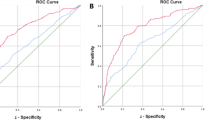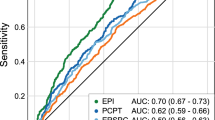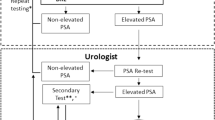Abstract
The American Cancer Society's updated screening guidelines for prostate cancer (CaP) render digital rectal examination (DRE) optional. We investigated the impact of DRE on CaP detection among obese men. Data from 2794 men undergoing initial prostate biopsy at three centers were analyzed to assess CaP risk attributed to abnormal DRE across body mass index (BMI) categories. Predictive accuracies of a combination of PSA, age, race, center and biopsy year including or excluding DRE findings were compared by areas under the receiver-operating characteristics curves. In all cohorts, obese men were less likely to have abnormal DREs diagnosed than non-obese men. As BMI category increased, abnormal DREs became stronger predictors for overall CaP in individual (P-trends⩽0.05) and combined (P-trend<0.001) cohorts, and for high-grade CaP in the Italian (P-trend=0.03) and combined (P-trend=0.03) cohorts. DRE inclusion improved the predictive accuracy for overall and high-grade CaP detection among all obese men (P⩽0.032) but not normal-weight men (P⩾0.198). DRE inclusion also near-significantly improved overall CaP detection in obese men with PSA<4 ng ml–1 (P=0.081). In conclusion, the predictive value of DRE is dependent on obesity and is significantly higher among obese men than normal-weight men.
This is a preview of subscription content, access via your institution
Access options
Subscribe to this journal
Receive 4 print issues and online access
$259.00 per year
only $64.75 per issue
Buy this article
- Purchase on Springer Link
- Instant access to full article PDF
Prices may be subject to local taxes which are calculated during checkout
Similar content being viewed by others
References
Stokes ME, Black L, Benedict A, Roehrborn CG, Albertsen P . Long-term medical-care costs related to prostate cancer: estimates from linked SEER-Medicare data. Prostate Cancer Prostatic Dis 2010; 13: 278–284.
Cecchini M, Sassi F, Lauer JA, Lee YY, Guajardo-Barron V, Chisholm D . Tackling of unhealthy diets, physical inactivity, and obesity: health effects and cost-effectiveness. Lancet 2010; 376: 1775–1784.
Freedland SJ, Bañez LL, Sun LL, Fitzsimons NJ, Moul JW . Obese men have higher-grade and larger tumors: an analysis of the Duke Prostate Center database. Prostate Cancer Prostatic Dis 2009; 12: 259–263.
Freedland SJ, Aronson WJ, Kane CJ, Presti Jr JC, Amling CL, Elashoff D et al. Impact of obesity on biochemical control after radical prostatectomy for clinically localized prostate cancer: a report by the Shared Equal Access Regional Cancer Hospital database study group. J Clin Oncol 2004; 22: 446–453.
Jayachandran J, Bañez LL, Aronson WJ, Terris MK, Presti Jr JC, Amling CL et al. Obesity as a predictor of adverse outcome across black and white race: results from the Shared Equal Access Regional Cancer Hospital (SEARCH) Database. Cancer 2009; 115: 5263–5271.
Ma J, Li H, Giovannucci E, Mucci L, Qiu W, Nguyen PL et al. Prediagnostic body-mass index, plasma C-peptide concentration, and prostate cancer-specific mortality in men with prostate cancer: a long-term survival analysis. Lancet Oncol 2008; 9: 1039–1047.
Parr CL, Batty GD, Lam TH, Barzi F, Fang X, Ho SC et al. Body-mass index and cancer mortality in the Asia-Pacific Cohort Studies Collaboration: pooled analyses of 424 519 participants. Lancet Oncol 2010; 11: 741–752.
Calle EE, Rodriguez C, Walker-Thurmond K, Thun MJ . Overweight, obesity, and mortality from cancer in a prospectively studied cohort of US adults. N Engl J Med 2003; 348: 1625–1638.
Bañez LL, Hamilton RJ, Partin AW, Vollmer RT, Sun L, Rodriguez C et al. Obesity-related plasma hemodilution and PSA concentration among men with prostate cancer. JAMA 2007; 298: 2275–2280.
Grubb III RL, Black A, Izmirlian G, Hickey TP, Pinsky PF, Mabie JE et al. Serum prostate-specific antigen hemodilution among obese men undergoing screening in the Prostate, Lung, Colorectal, and Ovarian Cancer Screening Trial. Cancer Epidemiol Biomarkers Prev 2009; 18: 748–751.
Hekal IA, Ibrahiem EI . Obesity-PSA relationship: a new formula. Prostate Cancer Prostatic Dis 2010; 13: 186–190.
Silk AW, McTigue KM . Reexamining the physical examination for obese patients. JAMA 2011; 305: 193–194.
van Leeuwen PJ, van Vugt HA, Bangma CH . The implementation of screening for prostate cancer. Prostate Cancer Prostatic Dis 2010; 13: 218–227.
Catalona WJ, Smith DS, Ratliff TL, Basler JW . Detection of organ-confined prostate cancer is increased through prostate-specific antigen-based screening. JAMA 1993; 270: 948–954.
Roehl KA, Han M, Ramos CG, Antenor JA, Catalona WJ . Cancer progression and survival rates following anatomical radical retropubic prostatectomy in 3478 consecutive patients: long-term results. J Urol 2004; 172: 910–914.
Schroder FH, van der Maas P, Beemsterboer P, Kruger AB, Hoedemaeker R, Rietbergen J et al. Evaluation of the digital rectal examination as a screening test for prostate cancer. Rotterdam section of the European Randomized Study of Screening for Prostate Cancer. J Natl Cancer Inst 1998; 90: 1817–1823.
Gosselaar C, Roobol MJ, van den Bergh RC, Wolters T, Schroder FH . Digital rectal examination and the diagnosis of prostate cancer--a study based on 8 years and three screenings within the European Randomized Study of Screening for Prostate Cancer (ERSPC), Rotterdam. Eur Urol 2009; 55: 139–146.
Gosselaar C, Roobol MJ, Roemeling S, van der Kwast TH, Schroder FH . Screening for prostate cancer at low PSA range: the impact of digital rectal examination on tumor incidence and tumor characteristics. Prostate 2007; 67: 154–161.
Schroder FH, Roobol-Bouts M, Vis AN, van der Kwast T, Kranse R . Prostate-specific antigen-based early detection of prostate cancer--validation of screening without rectal examination. Urology 2001; 57: 83–90.
Hugosson J, Carlsson S, Aus G, Bergdahl S, Khatami A, Lodding P et al. Mortality results from the Goteborg randomised population-based prostate-cancer screening trial. Lancet Oncol 2010; 11: 725–732.
Wolf AM, Wender RC, Etzioni RB, Thompson IM, D’Amico AV, Volk RJ et al. American Cancer Society guideline for the early detection of prostate cancer: update 2010. CA Cancer J Clin 2010; 60: 70–98.
Okotie OT, Roehl KA, Han M, Loeb S, Gashti SN, Catalona WJ . Characteristics of prostate cancer detected by digital rectal examination only. Urology 2007; 70: 1117–1120.
Borden Jr LS, Wright JL, Kim J, Latchamsetty K, Porter CR . An abnormal digital rectal examination is an independent predictor of Gleason > or =7 prostate cancer in men undergoing initial prostate biopsy: a prospective study of 790 men. BJU Int 2007; 99: 559–563.
Thompson IM, Ankerst DP, Chi C, Goodman PJ, Tangen CM, Lucia MS et al. Assessing prostate cancer risk: results from the Prostate Cancer Prevention Trial. J Natl Cancer Inst 2006; 98: 529–534.
DeLong ER, DeLong DM, Clarke-Pearson DL . Comparing the areas under two or more correlated receiver operating characteristic curves: a nonparametric approach. Biometrics 1988; 44: 837–845.
Greene KL, Albertsen PC, Babaian RJ, Carter HB, Gann PH, Han M et al. Prostate specific antigen best practice statement: 2009 update. J Urol 2009; 182: 2232–2241.
Heidenreich A, Bellmunt J, Bolla M, Joniau S, Mason M, Matveev V et al. EAU Guidelines on Prostate Cancer. Part 1: screening, diagnosis, and treatment of clinically localised disease. Eur Urol 2010; 59: 61–71.
Catalona WJ, Richie JP, Ahmann FR, Hudson MA, Scardino PT, Flanigan RC et al. Comparison of digital rectal examination and serum prostate specific antigen in the early detection of prostate cancer: results of a multicenter clinical trial of 6630 men. J Urol 1994; 151: 1283–1290.
Schroder FH, Hugosson J, Roobol MJ, Tammela TL, Ciatto S, Nelen V et al. Screening and prostate-cancer mortality in a randomized European study. N Engl J Med 2009; 360: 1320–1328.
Andriole GL, Crawford ED, Grubb III RL, Buys SS, Chia D, Church TR et al. Mortality results from a randomized prostate-cancer screening trial. N Engl J Med 2009; 360: 1310–1319.
Pinsky PF, Andriole GL, Kramer BS, Hayes RB, Prorok PC, Gohagan JK . Prostate biopsy following a positive screen in the prostate, lung, colorectal and ovarian cancer screening trial. J Urol 2005; 173: 746–750; discussion 750–741.
La Rochelle J, Amling CL . Prostate cancer screening: what we have learned from the PLCO and ERSPC trials. Curr Urol Rep 2010; 11: 198–201.
Freedland SJ, Wen J, Wuerstle M, Shah A, Lai D, Moalej B et al. Obesity is a significant risk factor for prostate cancer at the time of biopsy. Urology 2008; 72: 1102–1105.
Freedland SJ, Platz EA, Presti Jr JC, Aronson WJ, Amling CL, Kane CJ et al. Obesity, serum prostate specific antigen and prostate size: implications for prostate cancer detection. J Urol 2006; 175: 500–504; discussion 504.
Parekh N, Lin Y, Dipaola RS, Marcella S, Lu-Yao G . Obesity and prostate cancer detection: insights from three national surveys. Am J Med 2010; 123: 829–835.
Wright ME, Chang SC, Schatzkin A, Albanes D, Kipnis V, Mouw T et al. Prospective study of adiposity and weight change in relation to prostate cancer incidence and mortality. Cancer 2007; 109: 675–684.
http://www.cdc.gov/obesity/data/trends.html, accessed on 28 September 2010.
Acknowledgements
We thank Ms Kathleen Shuler and Mr Enwono Eyoh for their help in data abstraction. This study was supported by National Institutes of Health, Department of Defense and the Duke Division of Urology.
Author information
Authors and Affiliations
Corresponding author
Ethics declarations
Competing interests
The authors declare no conflict of interest.
Rights and permissions
About this article
Cite this article
Chu, D., De Nunzio, C., Gerber, L. et al. Predictive value of digital rectal examination for prostate cancer detection is modified by obesity. Prostate Cancer Prostatic Dis 14, 346–353 (2011). https://doi.org/10.1038/pcan.2011.31
Received:
Revised:
Accepted:
Published:
Issue Date:
DOI: https://doi.org/10.1038/pcan.2011.31
Keywords
This article is cited by
-
Selective Bone Scan staging for patients with Prostate cancer: do absolute categories really make sense?
Prostate Cancer and Prostatic Diseases (2022)
-
Does increased body mass index lead to elevated prostate cancer risk? It depends on waist circumference
BMC Cancer (2020)
-
Obesity and prostate cancer-specific mortality after radical prostatectomy: results from the Shared Equal Access Regional Cancer Hospital (SEARCH) database
Prostate Cancer and Prostatic Diseases (2017)
-
Metabolic syndrome and prostate cancer risk in a population-based case–control study in Montreal, Canada
BMC Public Health (2015)
-
Left lobe of the prostate during clinical prostate cancer screening: the dark side of the gland for right-handed examiners
Prostate Cancer and Prostatic Diseases (2014)



